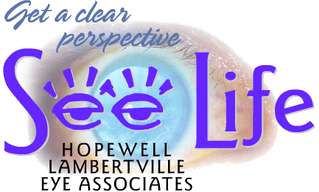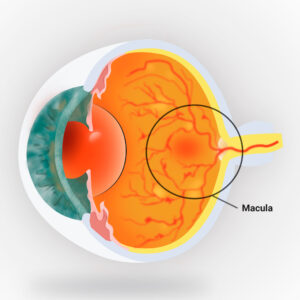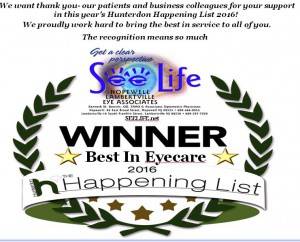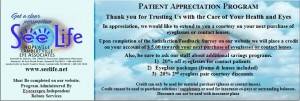Advanced-age adults who face increased odds of developing a degenerative eye disease frequently narrow their worries to conditions that are most in the spotlight and/or prevalent, such as the world’s two leading causes of blindness — cataract and glaucoma. Lost in this mix among senior Americans is adequate awareness of age-related macular degeneration (AMD).
Individuals, ages 65 and older, AMD (age related macular degeneration is the leading cause of vision loss and blindness. Nearly two million Americans have AMD, which causes harm to the sufferer’s central vision and limits his/her ability to read, write and recognize faces. Dry AMD (atrophic AMD) affects 8 out of 10 sufferers and is caused by the slow deterioration, or thinning, of the macula over time. Wet AMD (advanced neovascular AMD), or late-stage AMD, is a less common, but more serious form of AMD. At this stage, quicker vision loss occurs when abnormal blood vessels grow in the back of the eye and damage the macula.
What are the cause and types of MD?
The exact cause of MD is unknown. However we know that is highly related to systemic co -morbidities of cardiovascular disease and diabetes. We compare the micro-vessels of the eye to an "old garden hose" in which the fluid still goes through but overtime the walls of the vessels weaken and start to leak allowing unwanted fluids to penetrate the retina and harden due to UVA light leading to significant visual distortion and potential loss of central vision.
AMD may occur when the retina does not get enough nutrients (substances needed for growth). Decreased nutrients cause the supporting tissues of the retina to break down and waste material to collect. The damaged tissues and waste material cause drusen to form under the retina. The light-sensitive cells of the eyes are then injured causing blurring in the center part of your sight. There are 2 types of MD:
- Dry MD is the most common and slowly causes mild vision loss. Dry MD can sometimes turn into the wet form of MD.
- Wet MD is more severe and can quickly damage your vision. It occurs when new, abnormal blood vessels grow in your retina. The blood vessels may break open, causing blood to leak out. Small scars may also form.
February is Age-Related Macular Degeneration Awareness Month. Throughout February, the American Academies of Ophthalmology and Optometry encourages senior adults to learn more about AMD as a serious degenerative eye disease that can cause irreversible vision loss or blindness if left untreated. There are preventive practices to reduce risk of developing AMD, as well as key points of awareness related to the subtle, often easy-to-miss signs when this disease develops:
Lifestyle
- Reduce Alcohol Consumption: A June 2021 Current Eye Research study found that moderate to high alcohol consumption was linked to a higher incidence of early AMD, compared with occasional or non-alcohol consumption. Once Dry January has ended, aging adults should aim to continue low- to no-alcohol consumption moving into the second month of the year.
2. Nutrition: In 2013, the National Eye Institute published results of the AREDS 2 (Age-Related Eye Disease Study 2), which found a multi-vitamin formula (antioxidant Vitamins C and E, lutein, beta carotene, and zinc) reduced risk in dry AMD patients of progression to advanced AMD. Eating a vitamin-rich diet with leafy greens, colorful vegetables and fatty fish gives aging adults an ace in the hand in preventing or slowing advancement of degenerative eye diseases like AMD.
3. Exercise: Hypertension, high cholesterol, and heart disease are all risk factors for AMD. As adults reach their 60s and older, staying active remains critical for reducing the likelihood of a degenerative eye diseases like AMD that primarily affect senior adults.
4. Quit or Avoid Smoking. Studies show smokers are twice as likely to develop AMD in comparison to non-smokers. Quitting smoking is the best step smokers can take toward lowering risk of developing AMD. People who quit smoking 20 years ago have the same risk of developing AMD as those who have never smoked.
Read more about Nutrition and Eye Health
https://www.seelife.net/eye-healthy-good-eating-good-snacking/
https://www.seelife.net/supplements-that-slow-amd-progression/
https://www.seelife.net/eye-disease-management/macular-degeneration-treatment/can-macular-degeneration-be-treated/
Awareness
- Heredity: AMD often runs in families, and genetics can play a role in up to 70 percent of AMD cases. To discuss with their eye specialist at their next comprehensive exam, aging adults should talk to close relatives to learn family history of AMD and other age-related ocular diseases.
- Routine Eye Exams: Getting a comprehensive eye exam by age 40 permits ophthalmologists/optometrists to screen for all age-related eye diseases such as AMD that cause vision loss, frequently before symptoms occur. The American Academy of Ophthalmology and Optometry recommends all healthy adults get a comprehensive eye exam by age 40 to screen for blinding eye diseases.
Multiple factors are at play that increase our risk for developing a degenerative eye disease as we age. Hopewell - Lambertville Eye Associates (www.seelife.net) encourages asymptomatic adults to have a comprehensive eye exam by age 40. By age 65, a routine eye exam is recommended every year.
Hopewell 609-466-0055
Lambertville: 609-397-7020





